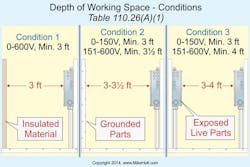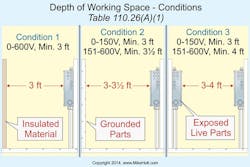Q. What are the basic working space requirements for electrical equipment?
A. For the purpose of safe operation and maintenance of equipment, access and working space must be provided about all electrical equipment. Equipment that may need examination, adjustment, servicing, or maintenance while energized must have working space provided in accordance with 110.26(A)(1), (2), and (3). (Note: The phrase “while energized” is the root of many debates. As always, check with the AHJ to see what equipment he or she believes needs a clear working space.)
Depth of working space
The working space, which is measured from the enclosure front, must not be less than the distances contained in Table 110.26(A)(1). (See Table and Figure).
Working space isn’t required for the back or sides of assemblies, where all connections and all renewable or adjustable parts are accessible from the front [110.26(A)(1)(a)].
If special permission is granted in accordance with Sec. 90.4, working space for equipment that operates at not more than 30VAC or 60VDC can be less than the distance in Table 110.26(A)(1) [110.26(A)(1)(b)]. (Note: See the definition of “Special Permission” in Art. 100.)
If electrical equipment is being replaced, Condition 2 of Table 110.26(A)(1) is permitted between dead-front switchboards, switchgear, panelboards, or motor control centers located across the aisle from each other where conditions of maintenance and supervision ensure that written procedures have been adopted to prohibit equipment on both sides of the aisle from being open at the same time, and only authorized, qualified persons will service the installation [110.26(A)(1)(c)]. (Note: The working space requirements of Sec. 110.26 don’t apply to equipment included in Chapter 8 – Communications Circuits [90.3].)
Width of working space
The width of the working space must be a minimum of 30 in., but in no case less than the width of the equipment [110.26(A)(2)]. The width of the working space can be measured from left-to-right, from right-to-left, or simply centered on the equipment, and the working space can overlap the working space for other electrical equipment.) In all cases, the working space must be of sufficient width, depth, and height to permit all equipment doors to open 90°.
Height of working space
The height of the working space in front of equipment must not be less than 6½ ft, measured from the grade, floor, platform, or the equipment height — whichever is greater [110.26(A)(3)]. Equipment such as raceways, cables, wireways, cabinets, panels, and so on, can be located above or below electrical equipment, but must not extend more than 6 in. into the equipment’s working space.
Exception No. 1: The minimum headroom requirement doesn’t apply to service equipment or panelboards rated 200A or less located in an existing dwelling unit. (Note: See the definition of “Dwelling Unit” in Art. 100.)
Exception No. 2: Meters are permitted to extend beyond the other equipment.
Clear space and guarding
The working space required by this section must be clear at all times. Therefore, this space isn’t permitted for storage [110.26(B)]. In addition, when normally enclosed live parts are exposed for inspection or servicing, the working space, if in a passageway or general open space, must be suitably guarded.
When working in a passageway, the working space should be guarded from occupants using it. When working on electrical equipment in a passageway one must be mindful of a fire alarm evacuation with numerous occupants congregated and moving through the area. Signaling and communications equipment must not be installed in a manner that encroaches on the working space of the electrical equipment.
Q. What are the uses permitted and not permitted for flexible cords?
A. Flexible cords and flexible cables within the scope of Art. 400 can be used for the following applications [400.7(A)]:
1) Pendants [210.50(A) and 314.23(H)] — only cords identified for use as pendants in Table 400.4 may be used for pendants [400.4]
2) Wiring of luminaires [410.24(A) and 410.62(B)]
3) Connection of portable luminaires, portable and mobile signs, or appliances
4) Elevator cables
5) Wiring of cranes and hoists
6) Connection of utilization equipment to facilitate frequent interchange [422.16].
7) Prevention of the transmission of noise or vibration [422.16].
8) Appliances where the fastening means and mechanical connections are specifically designed to permit ready removal for maintenance and repair, and the appliance is intended or identified for flexible cord connections.
9) Connection of moving parts (Note: Flexible cords and flexible cables are permitted for fixed permanent wiring by 501.10, 501.140, 502.10 502.140, 503.10, 503.140, 550.10(B), 553.7(B), and 555.13(A)(2).)
Attachment plugs are required for flexible cords used in any of the following applications [400.7(B)]:
- Portable luminaires, portable and mobile signs, or appliances [400.7(A)(3)]
- Stationary equipment to facilitate its frequent interchange [400.7(A)(6)]
- Appliances specifically designed to permit ready removal for maintenance and repair, and identified for flexible cord connection [400.7(A)(8)]
An attachment plug can serve as the disconnecting means for stationary appliances [422.33] and room air conditioners [440.63].
Unless specifically permitted in Sec. 400.7, the following uses are not permitted [400.8]:
1) Flexible cords must not be used as a substitute for the fixed wiring of a structure.
2) Flexible cords must not be run through holes in walls, structural ceilings, suspended or dropped ceilings, or floors. (Note: Article 400 requirements only apply to flexible cords [UL 62]; power supply cords [UL 817] don’t fall within the scope of Art. 400, therefore a power supply cord is permitted to run through a cabinet wall for an appliance.)
3) Flexible cords must not be run through doorways, windows, or similar openings.
4) Flexible cords must not be attached to building surfaces.
5) Flexible cords must not be concealed by walls, floors, or ceilings, or located above suspended or dropped ceilings. (Note: Flexible cords are permitted under a raised floor (with removable panels) not used for environmental air, because this area isn’t considered a concealed space. See the definition of “Exposed” in Art. 100. In addition, Art. 400 requirements only apply to flexible cords [UL 62]; power supply cords [UL 817] do not fall within the Scope of Art. 400. Therefore a power supply cord is permitted to run through or be located above a suspended ceiling.)
6) Flexible cords must not be installed in raceways, except as permitted by Sec. 400.14 for industrial establishments where the conditions of maintenance and supervision ensure that only qualified persons will service the installation.
7) Flexible cords must not be subject to physical damage. (Note: Even cords listed as “extra-hard usage” must not be used where subject to physical damage.)
Holt is the owner of Mike Holt Enterprises, Inc. in Leesburg, Fla. He can be reached at www.mikeholt.com.
About the Author

Mike Holt
Mike Holt is the owner of Mike Holt Enterprises (www.MikeHolt.com), one of the largest electrical publishers in the United States. He earned a master's degree in the Business Administration Program (MBA) from the University of Miami. He earned his reputation as a National Electrical Code (NEC) expert by working his way up through the electrical trade. Formally a construction editor for two different trade publications, Mike started his career as an apprentice electrician and eventually became a master electrician, an electrical inspector, a contractor, and an educator. Mike has taught more than 1,000 classes on 30 different electrical-related subjects — ranging from alarm installations to exam preparation and voltage drop calculations. He continues to produce seminars, videos, books, and online training for the trade as well as contribute monthly Code content to EC&M magazine.


